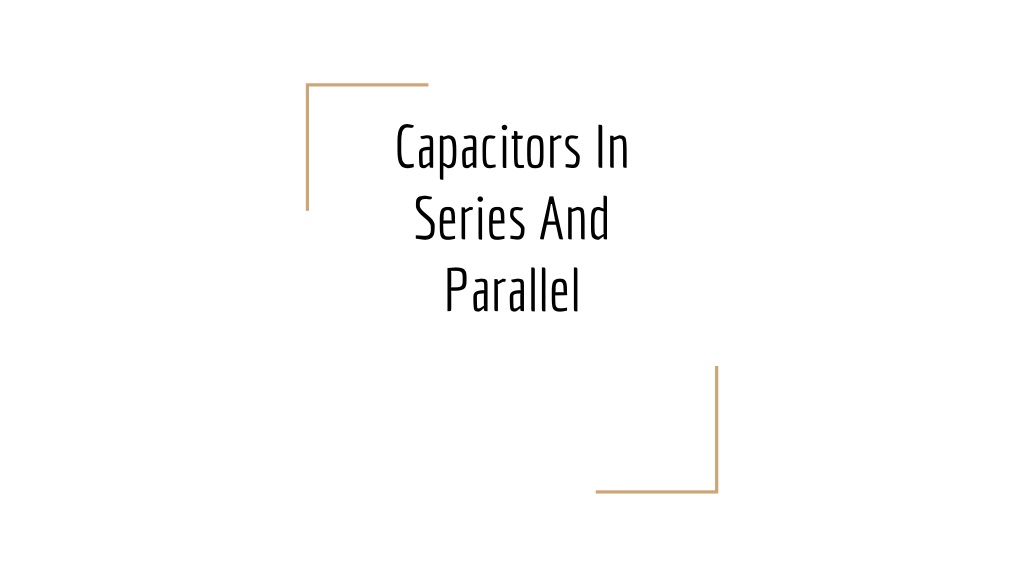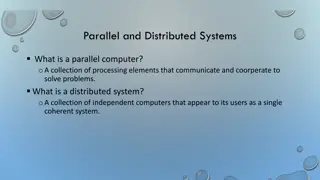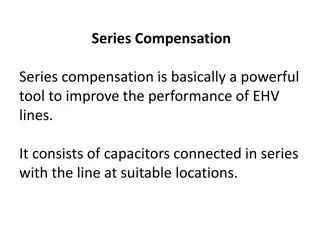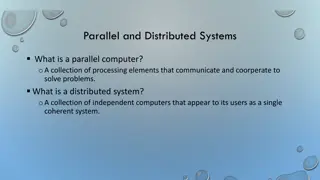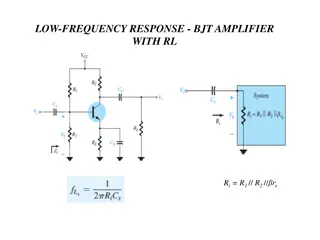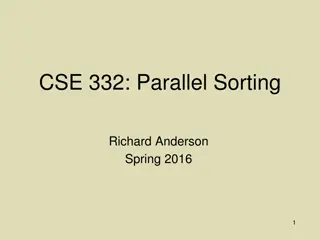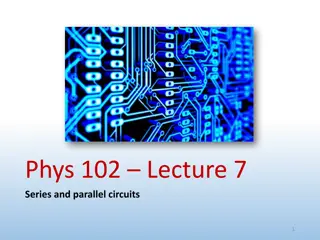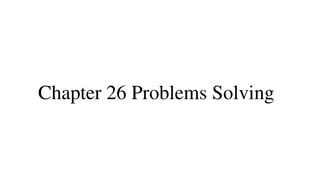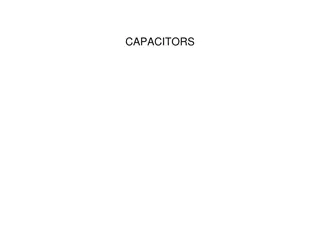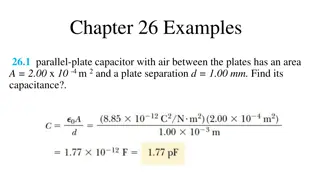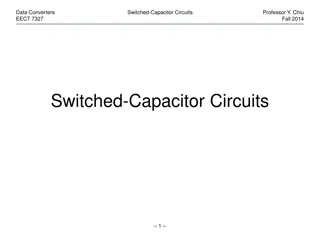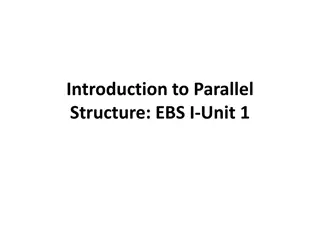Capacitors in Series and Parallel
Capacitors are essential components for storing electrical charges, and combining them in series or parallel can alter their overall capacitance and voltage ratings. In series connections, the charges evenly distribute over all capacitors, affecting the equivalent capacitance. Despite the decrease in capacitance, series connections offer advantages such as voltage manipulation and cost efficiency.
Download Presentation

Please find below an Image/Link to download the presentation.
The content on the website is provided AS IS for your information and personal use only. It may not be sold, licensed, or shared on other websites without obtaining consent from the author. Download presentation by click this link. If you encounter any issues during the download, it is possible that the publisher has removed the file from their server.
E N D
Presentation Transcript
Capacitors In Series And Parallel
Overview - - Capacitors are used to store charges of electricity. Often the total load that they can store, along with their working voltages, is standardized in production. It is not uncommon for these standard capacitances and voltages to be different from what is actually needed in a project. In order to overcome this, often times capacitors will be combined in series or parallel. How does this work though? - - -
Factors affecting capacitance + Plate area + Plate spacing + Dielectric material
Series Connections - A series connection is formed when capacitors are linked, one after the other, by a conducting circuit. When capacitors are linked in this way, it causes the charges from the connection points the series is linked to, to evenly distribute over all the capacitors in the series. This means that in a series connection, the magnitude of charge on all plates is the same! - -
Series Connections - The effect of using capacitors in a series can be seen when examining the equivalent capacitor - Here, Ceqis the equivalent capacitance of a series combination, and C1, C2, and C3are all connected capacitors in a series.
Series Connections - The effect of using capacitors in a series can be seen when examining the capacitance equivalence relation: - By connecting strings of smaller capacitors, the overall capacitance will be decreased proportional to the number of capacitors in series and their individual capacitance values. For example, three capacitors of equal charge in sequence together, will produce one third of their capacitance. -
Series Connections Example - Here we can see an example where capacitors are strung together in a series. Calculating the total capacitance of this series would follow: - 1/.1 F + 1/.2 F + 1/.3 F = 1/Ctotal----> Ctotal= .0545 F
Advantage Of Series Connections - If the capacitance sees a decrease due to series connections, then why would anyone want to connect capacitors in this way? The two biggest advantages are voltage manipulation, and cost! While the equivalent capacitance will see an overall decrease, the voltage rating will usually see an increase somewhere! In the example earlier, where three capacitors were connected in sequence, the overall capacitance would be reduced to .0545 F, however, in a series circuit, the voltage drop across each capacitor adds up to the total applied voltage (V = V1 + V2 + +Vn) - - -
Advantage Of Series Connections - This means that a clever engineer could design their series connections so that certain nodes of their circuit network receive a larger charge than others. Although somewhat situational, this is still a handy trick to have at disposal. -
Advantage Of Series Connections - - The other advantage to using series connections is usually cost. If a project design uses many large capacitors, but only a handful of smaller ones, it is usually cheaper to use a series connection of large capacitors to get the same result, due to the bulk amount of large capacitors that would be purchased. Although less physics-based, this is still an important consideration that would be addressed in real world application. -
Capacitors In Parallel - When the upper and lower plates of two or more capacitors are connected by circuits in parallel between the original connection points, it s called a Parallel Connection. In this kind of connection, the upper plates form one equipotential surface, and the lower plates form another equipotential surface of their own. -
Capacitors In Parallel - Because of this, the electric potential difference in all capacitors in a parallel connection is the same. V = V1 = V2 = V3 = = Vn - Example of a parallel capacitor connection:
Capacitors In Parallel - When capacitors are used in parallel, the total charge of the combination is additive. That is, the total charge Q, is equal to the charge on every connected capacitor added together. The charge of each individual capacitor can be calculated using the formula Q=CV, where Q is the charge of the capacitor, C is the capacitor s capacitance, and V is the voltage in question. - -
Capacitors In Parallel Example -In the example provided earlier: - - Figuring out the charges on each individual capacitor would follow: QI1= (.1*10^-6)(12) = (1.2*10^-6)c; QI2= (.2*10^-6)(12)= (2.4*10^-6)c; and QI3= (.3*10^-6)(12) = (3.6*10^-6)c
Capacitors In Parallel Example -In the example provided earlier: - Figuring out the total charge on the capacitors in parallel would then follow: QI1+ QI2 + QI3= (1.2*10^-6) + (2.4*10^-6) + (3.6*10^-6) = (7.2*10^-6)c -
Capacitors In Parallel - Another useful feature of keeping capacitors in parallel, is that the total capacitance of the build is additive as well. In a parallel capacitor combination, the total equivalent capacitance will be equal to the capacitance of every capacitor in parallel added together: - Ctotal = C1 + C2 + C3 + + Cn
Capacitors In Parallel - Again, using the previous example: - The total equivalent capacitance of this parallel combination would be: .1 F + .2 F + .3 F = .6 F
Advantage Of Using Capacitors In Parallel - The most obvious advantage of using capacitors in parallel is that it allows a system to store a larger charge. Another advantage is that it can allow a system to achieve a non- preferred capacitance value. Typically, in real world application, capacitors come in standardized values, called preferred values. If a project requires a larger capacitance that is not preferred, one can manipulate the capacitance of the system to the required value, by using a parallelized design. - - -
Calculating Charge On Capacitors - Whether configured in series or parallel, capacitors will always be used for the same basic purpose; to store a charge. It turns out that calculating the charge on a capacitor is relatively simple. Using the equation Q=C V, it is possible to figure out the charge on any capacitor in question! In the equation, Q represents the charge on the capacitor, C represents the capacitance value, and V represents the potential energy being fed to the capacitor. - - -
Calculating Charge On Capacitors - Recall the example from earlier used as the parallel arrangement: - How were the charges calculated when we got to this step? QI1= (.1*10^-6)(12) = (1.2*10^-6)c; QI2= (.2*10^-6)(12)= (2.4*10^-6)c; and QI3= (.3*10^-6)(12) = (3.6*10^-6)c
Calculating Charge On Capacitors - Recall the example from earlier used as the parallel arrangement: - Every value used to calculate the charge Q corresponded to some part of the given information.
Calculating Charge On Capacitors - Recall the example from earlier used as the parallel arrangement: - In the case of QI1, the capacitance of 0.1 F became our .1*10^-6, and the voltage 12v became the 12, resulting in: QI1= (.1*10^-6)(12) = (1.2*10^-6)c
Series and Parallel Combination Capacitors (Capacitance) Three capacitors connected to each other and a power supply V. + Total capacitance: 1/C = 1/C12 + 1/C3 => C = C12*C3/C12C3 = (C1+C2)*C3/(C1+C2+C3) (C1 and C2 are connected parallel, C12 and C3 are connected in series)
Series and Parallel Capacitors (charge and voltage) + + Total charge: Q = CV Q3 = Q12 = Q since C12 and C3 and U connected in series Voltage on 3rd capacitor: V3 = Q3/C3 = Q/C3 V = V12 + V3 => V12 = V - V3 V1 = V2 = V12 since V1 and V2 are connected parallel Q1 = C1V1 Q2 = C2V2 + + + + +
